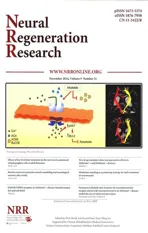Hot spots and future directions of research on the neuroprotective effects of nimodipine
2014-04-07RunhuiLi
Runhui Li
Department of Neurology, Af fi liated Central Hospital of Shenyang Medical College, Shenyang, Liaoning Province, China
Hot spots and future directions of research on the neuroprotective effects of nimodipine
Runhui Li
Department of Neurology, Af fi liated Central Hospital of Shenyang Medical College, Shenyang, Liaoning Province, China
Calcium antagonists are widely used in the clinical treatment of ischemic cerebrovascular disease because of their vascular and neuroprotective effects. Nimodipine, a typical calcium antagonist, can cross the blood-brain barrier and act selectively at neurons and blood vessels of target tissues, thus exerting neuroprotective effects. The aim of the present study was to explore the hot spots and future trends of research on the neuroprotective effects of nimodipine. We retrieved 425 articles on the neuroprotective effects of nimodipine that were indexed in the Web of the Science database between 2000 and 2014. The retrieved articles were analyzed using document analysis reporting and the derived information function in the Web of Science, and the information visualization software CiteSpace III. The reference co-citation network was plotted, and the high frequency key words in these publications were used to analyze the research fronts and development trends for nimodipine neuroprotection. According to these co-citation clusters, the research front of nimodipine neuroprotection is the use of randomized controlled trials to study nimodipine intervention of subarachnoid hemorrhage. Using time zone view analysis on hot spots labeled with a key word, the areas of interest in the field of nimodipine neuroprotection are nimodipine pharmacology and therapeutics, blood-brain barrier, trials, and anti-angiospasm.
neuroprotection; nerve regeneration; nimodipine; ischemic cerebrovascular disease; Web of Science; CiteSpace; research fronts; development trends; scientific mapping; visualization
Li RH. Hot spots and future directions of research on the neuroprotective effects of nimodipine. Neural Regen Res. 2014;9(21):1933-1938.
Introduction
Current treatments for acute ischemic cerebrovascular disease include thrombolysis, de fi brination and anticoagulation therapy, but these are associated with severe adverse effects such as bleeding, resulting in a poor prognosis. Nimodipine is widely recognized as a neuroprotective agent. It is a fat-soluble drug that can cross the blood-brain barrier and act selectively at target neurons and blood vessels in the brain, exerting protective effects on injured neurons. Therefore, nimodipine is widely used to improve blood circulation during the convalescent period after acute cerebrovascular disease, and to improve cerebral angiospasm caused by subarachnoid hemorrhage (Babu et al., 2011; Wang et al., 2012; Justin et al., 2014).
An area gaining increasing interest is the investigation of study dynamics and development trends in specialist research fields, using knowledge mapping. CiteSpace III is an information visualization tool developed by Professor Chen from Drexel University, Philadelphia, USA in 2005 (Chen, 2005). It can visualize the trends and patterns in a field or domain within a designated period of time. CiteSpace III has been used to analyze the knowledge structure, hot spots, frontiers and pivotal points in regenerative medicine research (Chen, 2014). Here, we present a visualization analysis of articles on the neuroprotective effects of nimodipine indexed in the Web of Science database during 2000-2014, using Citespace III software, to explore the research fronts and trends in studies of nimodipine administration.
Data and Methods
Data source and methodology
Online retrieval (http://apps.webofknowledge.com) from the Web of Science was performed by the fi rst author using the key words “nimodipine” and “nerve” to screen research articles or reviews published in English between 2000 and 2014. The retrieval was carried out on 30thOctober 2014 and 425 publications were included in the fi nal analysis. The Web of Science Core Collection consists of the Science Citation Index Expanded (SCI-Expanded), Social Sciences Citation Index (SSCI), Arts & Humanities Citation Index (A&HCI), Conference Proceedings Citation Index-Science (CPCI-S), and Conference Proceedings Citation Index-Social Science & Humanities (CPCI-SSH). The following information was downloaded for each publication: authors, title, abstract, institution, descriptors and identi fi ers. The downloaded data were input into and analyzed by the CiteSpace III visualization tool.
Inclusion criteria
(1) Peer-reviewed articles on the neuroprotective effect of nimodipine, including original basic and clinical studies and reviews. (2) Articles published in 2000-2014 (inclusive). (3) Articles indexed in the Web of Science database. (4) Articles with abstracts and citations.
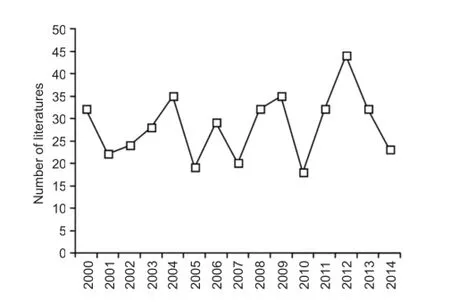
Figure 1 Yearly output of publications on the neuroprotective effect of nimodipine indexed in the Web of Science during 2000-2014.

Figure 2 Distribution of publications indexed in the Web of Science between 2000 and 2014 on the neuroprotective effect of nimodipine across different countries.

Figure 3 Authors of the most articles on the neuroprotective effect of nimodipine, indexed in the Web of Science database in 2000-2014.

Figure 4 Institutions publishing the most articles on the neuroprotective effect of nimodipine, indexed in the Web of Science database in 2000-2014.

Figure 5 Funding sources for published studies on the neuroprotective effects of nimodipine, indexed by the Web of Science database during 2000-2014.
Exclusion criteria
(1) Publications that required manual searching or telephone access. (2) Documents that were not published in the public domain. (3) Meeting abstracts, proceedings, corrected articles, and repeated articles.
Quality assessment
English articles or reviews meeting the inclusion criteria were included in this study.
Analysis and discussion
A total of 425 publications were indexed in the Web of Science database between 2000 and 2014 (Figure 1). The distribution of these publications across different countries is shown in Figure 2.
Number of documents
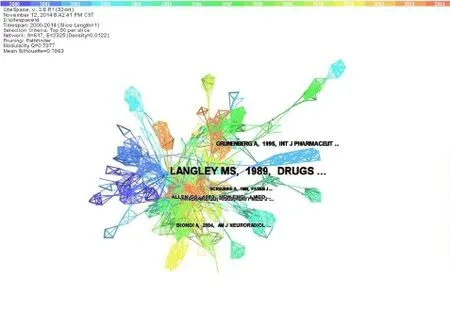
Figure 6 Co-citaion-burst term visualization analysis network knowledge map.

Figure 7 Literature-coword network visualization map in the field of nimodipine neuroprotection.
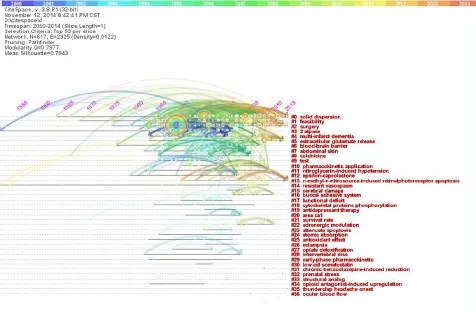
Figure 8 High-frequency key words in publications on nimodipine neuroprotection.

Table 1 Top-cited publications on the neuroprotective effect of nimodipine, indexed in the Web of Science between 2000 and 2014
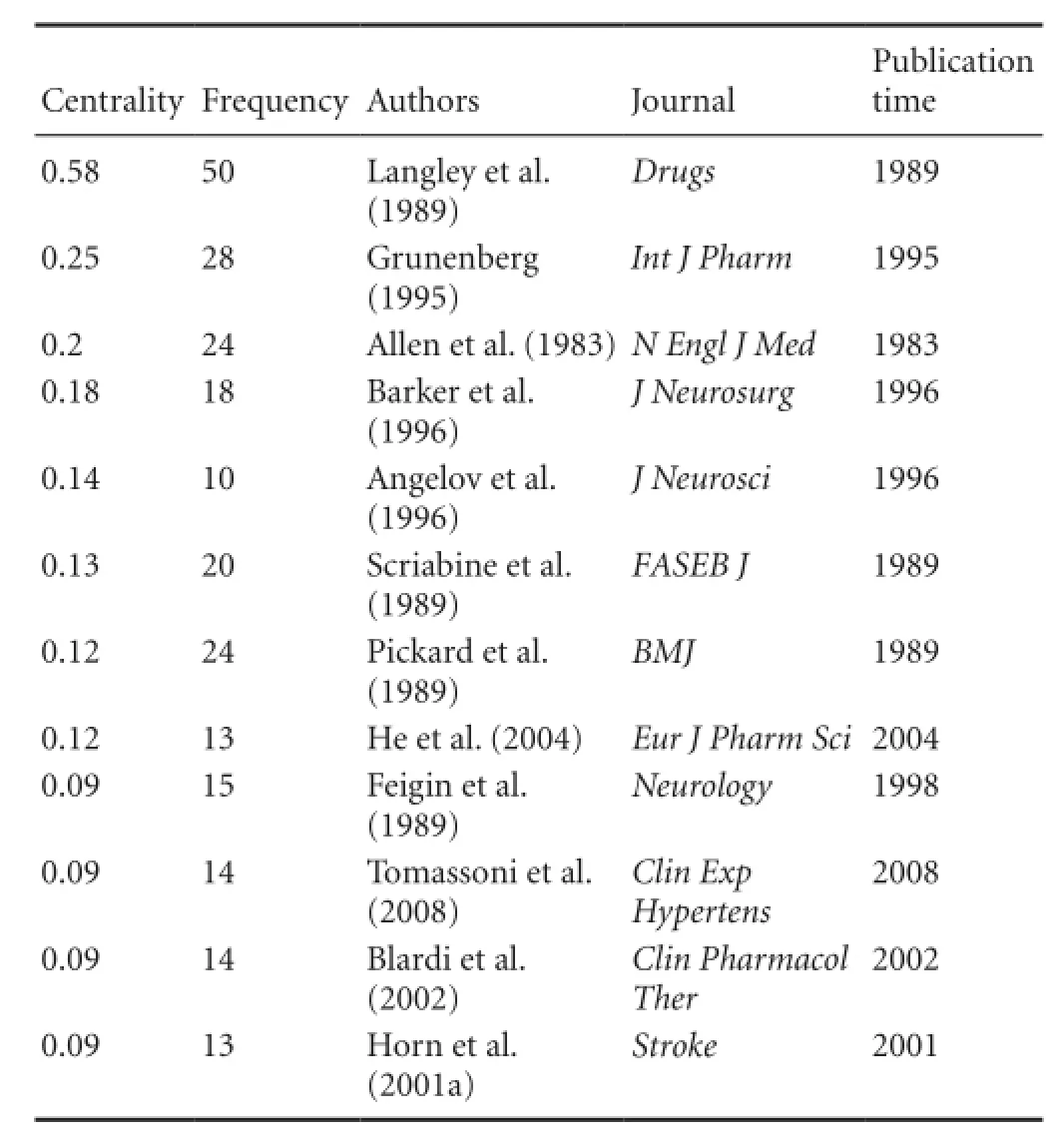
Table 2 Highly cited (“classical”) publications retrieved by Citespace III visualization software
A total of 425 articles on the neuroprotective effect of nimodipine were published during 2000-2014 and retrieved from the Web of Science. The number of relevant publications gradually increased after 2010, and peaked in 2012 (Figure 2). The total number of publications in the Web of Science increased over time.
Worldwide distribution
China published the highest number (77) of papers on the neuroprotective effect of nimodipine, followed by the USA (55) and Germany (44) (Figure 3).
Authors and institutions
Among the authors indexed by the Web of Science database during 2000-2014 that published on the neuroprotective effect of nimodipine, Tang published the most articles (10) (Figure 3). The 10 institutions with the greatest output of articles in this area included Shenyang Pharmaceutical University in China (20), China Pharmaceutical University (12), the Universities of Duesseldorf (10) and Munich (6) in Germany, and in India, the Postgraduate Institute of Medical Education and Research (8), Andhra University (7), and the All India Institute of Medical Science (6) (Figure 4).
Funding
The National Natural Science Foundation of China and the National Key Basic Research and Development Program (973Program) of China sponsored 18 of the articles retrieved in our search. The National Commission on Science and Technology Development in Brazil sponsored 6 publications. The Coordenação de Aperfeiçoamento de Pessoal de Nível Superior (the Brazilian Federal Agency for the Support and Evaluation of Graduate Education) sponsored four publications, and the Oak Ridge Institute for Science and Education, NIH Project, Kyung Hee University, German Federal Ministry of Education and Research and Bayer Vital GmbH Leverkusen each provided funding for two studies (Figure 5).
Disciplines and journals
The majority of articles on the neuroprotective effects of nimodipine indexed by the Web of Science database during 2000-2014 were in the field of neuroscience (169), followed by pharmacology (133), surgery (52), chemistry (48), and other fields (30). Neuroscience journals includedNeurosurgery,Stroke,Brain Research, andAmerican Journal of Neuroradiology; pharmacology journals includedInternational Journal of Pharmaceutics,Drug Development and Industrial Pharmacy,Acta Pharmacologica Sinica,andPharmacological Research(Table 1).
The ten most cited publications on the neuroprotective effect of nimodipine indexed by the Web of Science database during 2000-2014 are shown in Table 1.
Visualization analysis of publications on the neuroprotective effect of nimodipine indexed in the Web of Science database between 2000 and 2014
Visualized networks for co-cited burst terms in articles on the neuroprotective effect of nimodipine that were indexed in the Web of Science database during 2000-2014 were created using Citespace III software and based on the following parameters: time slicing = 1; time zone = 5 years (2000-2014, inclusive); threshold value = (2, 2, 20), (4, 3, 20), (4, 3, 20); node type = “burst terms”. Data retrieved were processed in 15 different periods, and 50 documents with high citation frequency were selected in each time zone. The networks were streamlined with the Path fi nder network scaling method, and the co-citation-burst term visualization analysis network was mapped (Figure 6), revealing 617 nodes and 2,325 lines. The highly cited publications with a centrality of more than 0.09 are shown in Table 2.
The research fronts in a field or domain are reflected by positive citations of publications and represent the thinking status of a research field. The most cited publications are located in the center of the diagram and represent the core achievements in this research field. The contribution of the publications in study progression is embodied by burst terms. Based on co-citation networks, top-cited publications were further analyzed and twelve publications were included; each had a new fi nding and induced a new trend of the study, guiding a new orientation. Horn et al. (2001a) published an article in Stroke in 2001 and ranked fifth in the number of total citations (99 citations), and had high centrality. The article primarily examined the effect of nimodipine pharmacokinetics on plasma adenosine levels in 12 cerebral ischemic patients (nine males and three females), with a mean age of 68.88 ± 11.2 years and mean body weight of 67.9 ± 9.3 kg. Intravenous nimodipine (0.03 mg/kg) and oral nimodipine (30, 60, 90 mg) were used. Blood samples were collected at fi xed times after nimodipine intervention, at intervals of 480 minutes. Plasma levels were determined with high performance liquid chromatography. The results showed that an injection of nimodipine induces an increase in plasma adenosine levels, which may be associated with drug activity.
A co-citation cluster is a network formed by co-cited publications and is used to investigate research fronts. The visualization analysis results showed that co-citation cluster of publications on neuroprotective effects of nimodipine is an approximately round network map. Each cluster in the periphery is relatively independent. The modularity Q was 0.7977 and the silhouette was 0.7943, suggesting that co-cited publications form an obvious and relatively independent cluster network. The data also indicate that the label of each cluster is relatively accurate and provides reliable evidence for data analysis.
Based on the included co-cited publications in this study, 45 co-citation clusters formed and were numbered 0-44, in ascending order of the number of publications in each cluster. According to the label in the co-citation cluster and analysis of the top-cited publications, the research front in nimodipine neuroprotection is the study of its use after subarachnoid hemorrhage using randomized controlled clinical trials.
Visualized networks for co-cited burst terms were created using the path fi nder method based on the following parameters: key word = node of network; node type = noun phrases; time zone = 1 year; thresholds = (2, 2, 20), (4, 3, 20), (4, 3, 20) (Figure 7). To further understand the hotspot in each period of time, a time zone view was used, taking key words as the label and helping us to understand the development of a field or an issue. According to the citation frequency and centricity, a hotspot in each period of time was selected. This revealed that nimodipine pharmacology and therapeutics, as well as blood-brain barrier and antiangiospasm, to be the areas of interest in the field of nimodipine neuroprotection between 2000 and 2014 (Figure 8).
Conclusion
A total of 425 articles on nimodipine neuroprotection were indexed in the Web of Science database between 2000 and 2014. The number of Web of Science publications in this field was highest in 2012 and the total number of publications increased with over time. Most publications (10) were authored by Tang. China ranked highest in the countries with most publications, followed by the USA and Germany. Among the institutes, Shenyang Pharmaceutical University and China Pharmaceutical University produced most articles, with the Universities of Duesseldorf and Munich also producing a large number of articles. The National Natural Science Foundation of China and the National Key Basic Re-search and Development Program (973 Program) of China sponsored 18 relevant articles. The National Commission on Science and Technology Development in Brazil sponsored six publications. Coordenação de Aperfeiçoamento de Pessoal de Nivel Superior sponsored four publications, whereas grants from the Oak Ridge Institute for Science and Education, NIH Project, Kyung Hee University, German Federal Ministry of Education and Research, and Bayer Vital GmbH Leverkusen supported two articles each. Relevant publications were mainly in the field of neuroscience (169), followed by pharmacology (133), surgery (52), and chemistry (48). Neuroscience-related journals includedNeurosurgery, Stroke,Brain Research,American Journal of Neuroradiology; pharmacology-related journals includedInternational Journal of Pharmaceutics,Drug Development and Industrial Pharmacy,Acta Pharmacologica Sinica, andPharmacological Research.
Visualized networks for co-cited burst terms in the field of nimodipine neuroprotection were created using the information visualization tool CiteSpace III and publications with significant influence were acquired. The co-citation cluster of publications on the neuroprotective effects of nimodipine is an approximately round network map, with 45 co-citation clusters. According to these co-citation clusters, the research front of nimodipine neuroprotection is the use of randomized controlled trials to study nimodipine intervention of subarachnoid hemorrhage. Using time zone view analysis on hot spots labeled with a key word, the areas of interest in the field of nimodipine neuroprotection are nimodipine pharmacology and therapeutics, blood-brain barrier, trials, and anti-angiospasm. Our fi ndings indicate that, increasing evidence has emphasized on the neuroprotection of nimodipine, which is mainly applied in the treatment of subarachnoid hemorrhage and at the same time, pharmacology is another hot spot.
Ahmed N, Näsman P, Wahlgren NG (2000) Effect of intravenous nimodipine on blood pressure and outcome after acute stroke. Stroke 31:1250-1255.
Allen GS, Ahn HS, Preziosi TJ, Battye R, Boone SC, Boone SC, Chou SN, Kelly DL, Weir BK, Crabbe RA, Lavik PJ, Rosenbloom SB, Dorsey FC, Ingram CR, Mellits DE, Bertsch LA, Boisvert DP, Hundley MB, Johnson RK, Strom JA, Transou CR (1983) Cerebral arterial spasm--a controlled trial of nimodipine in patients with subarachnoid hemorrhage. N Engl J Med 308:619-624.
Angelov DN, Neiss WF, Streppel M, Andermahr J, Mader K, Stennert E (1996) Nimodipine accelerates axonal sprouting after surgical repair of rat facial nerve. J Neurosci 16:1041-1048.
Babu CS, Ramanathan M (2011) Post-ischemic administration of nimodipine following focal cerebral ischemic-reperfusion injury in rats alleviated excitotoxicity, neurobehavioural alterations and partially the bioenergetics. Int J Dev Neurosci 29:93-105.
Barker FG 2nd, Ogilvy CS (1996) Ef fi cacy of prophylactic nimodipine for delayed ischemic de fi cit after subarachnoid hemorrhage: a metaanalysis. J Neurosurg 84:405-414.
Belfort MA, Anthony J, Saade GR, Allen JC Jr; Nimodipine Study Group (2003) A comparison of magnesium sulfate and nimodipine for the prevention of eclampsia. N Engl J Med 348:304-311.
Biondi A, Ricciardi GK, Puybasset L, Abdennour L, Longo M, Chiras J, Van Effenterre R (2004) Intra-arterial nimodipine for the treatment of symptomatic cerebral vasospasm after aneurysmal subarachnoid hemorrhage: preliminary results. AJNR Am J Neuroradiol 25:1067-1076.
Blardi P, Urso R, De Lalla A, Volpi L, Perri TD, Auteri A (2002) Nimodipine: drug pharmacokinetics and plasma adenosine levels in patients affected by cerebral ischemia. Clin Pharmacol Ther 72:556-561.
Chen C, Chen Y (2005) CiteSpace Searching for clinical evidence in CiteSpace. AMIA Annu Symp Proc:121-125.
Chen C, Dubin R, Kim MC (2014) Emerging trends and new developments in regenerative medicine: a scientometric update (2000-2014). Expert Opin Biol Ther 14:1295-1317.
Feigin VL, Rinkel GJ, Algra A, Vermeulen M, van Gijn J (1998) Calcium antagonists in patients with aneurysmal subarachnoid hemorrhage: a systematic review. Neurology 50:876-883.
Grunenberg A, Keila B, Henckb JO (1995) Polymorphism in binary mixtures, as exempli fi ed by nimodipine. Int J Pharmaceut 118:11-21.
He Z, Zhong D, Chen X, Liu X, Tang X, Zhao L (2004) Development of a dissolution medium for nimodipine tablets based on bioavailability evaluation. Eur J Pharm Sci 21:487-491.
Horn J, de Haan RJ, Vermeulen M, Luiten PG, Limburg M (2001a) Nimodipine in animal model experiments of focal cerebral ischemia: a systematic review. Stroke 32:2433-2438.
Horn J, de Haan RJ, Vermeulen M, Limburg M (2001b) Very Early Nimodipine Use in Stroke (VENUS): a randomized, double-blind, placebo-controlled trial. Stroke 32:461-465.
Justin A, Sathishkumar M, Sudheer A, Shanthakumari S, Ramanathan M (2014) Non-hypotensive dose of telmisartan and nimodipine produced synergistic neuroprotective effect in cerebral ischemic model by attenuating brain cytokine levels. Pharmacol Biochem Behav 122:61-73.
Langley MS, Sorkin EM (1989) Nimodipine. A review of its pharmacodynamic and pharmacokinetic properties, and therapeutic potential in cerebrovascular disease. Drugs 37:669-699.
Pantoni L, Rossi R, Inzitari D, Bianchi C, Beneke M, Erkinjuntti T, Wallin A (2000) Ef fi cacy and safety of nimodipine in subcortical vascular dementia: a subgroup analysis of the Scandinavian Multi-Infarct Dementia Trial. J Neurol Sci 175:124-134.
Pickard JD, Murray GD, Illingworth R, Shaw MD, Teasdale GM, Foy PM, Humphrey PR, Lang DA, Nelson R, Richards P (1989) Effect of oral nimodipine on cerebral infarction and outcome after subarachnoid haemorrhage: British aneurysm nimodipine trial. BMJ 298:636-642.
Schmid-Elsaesser R, Kunz M, Zausinger S, Prueckner S, Briegel J, Steiger HJ (2006) Intravenous magnesium versus nimodipine in the treatment of patients with aneurysmal subarachnoid hemorrhage: a randomized study. Neurosurgery 58:1054-1065.
Scriabine A, Schuurman T, Traber J (1989) Pharmacological basis for the use of nimodipine in central nervous system disorders. FASEB J 3:1799-1806.
Sobrado M, López MG, Carceller F, García AG, Roda JM (2003) Combined nimodipine and citicoline reduce infarct size, attenuate apoptosis and increase bcl-2 expression after focal cerebral ischemia. Neuroscience 118:107-113.
Taragano FE, Allegri R, Vicario A, Bagnatti P, Lyketsos CG (2001) A double blind, randomized clinical trial assessing the efficacy and safety of augmenting standard antidepressant therapy with nimodipine in the treatment of ‘vascular depression’. Int J Geriatr Psychiatry 16:254-260.
Tomassoni D, Lanari A, Silvestrelli G, Traini E, Amenta F (2008) Nimodipine and its use in cerebrovascular disease: evidence from recent preclinical and controlled clinical studies. Clin Exp Hypertens 30:744-766.
Wang P, Wang Y, Feng T, Zhao X, Zhou Y, Wang Y, Shi W, Ju Y; NICE Study Investigators (2012) Rationale and design of a double-blind, placebo-controlled, randomized trial to evaluate the safety and ef ficacy of nimodipine in preventing cognitive impairment in ischemic cerebrovascular events (NICE). BMC Neurol 12:88.
Zhang Q, Jiang X, Jiang W, Lu W, Su L, Shi Z (2004) Preparation of nimodipine-loaded microemulsion for intranasal delivery and evaluation on the targeting ef fi ciency to the brain. Int J Pharm 275:85-96.
Copyedited by Murphy JS, Norman C, Li YL, Yang Y, Li CH, Song LP, Zhao M
Runhui Li, Department of Neurology, Affiliated Central Hospital of Shenyang Medical College, Shenyang 110024, Liaoning Province, China, Lirh710717@163.com
10.4103/1673-5374.145365
s
http://www.nrronline.org/
Accepted: 2014-10-16
杂志排行
中国神经再生研究(英文版)的其它文章
- Reversible lesions in the brain parenchyma in Wilson’s disease con fi rmed by magnetic resonance imaging: earlier administration of chelating therapy can reduce the damage to the brain
- Effects of diazepam on glutamatergic synaptic transmission in the hippocampal CA1 area of rats with traumatic brain injury
- The occurrence of diffuse axonal injury in the brain: associated with the accumulation and clearance of myelin debris
- Adult neurogenesis in the four-striped mice (Rhabdomys pumilio)
- Amyloid precursor-like protein 2 C-terminal fragments upregulate S100A9 gene and protein expression in BV2 cells
- Recovery of cerebellar peduncle injury in a patient with a cerebellar tumor: validation by diffusion tensor tractography
